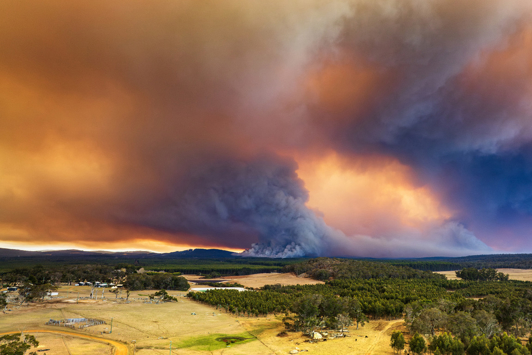- To use the Extreme weather events tool, select a date or dates you are interested in looking at. It is suggested you look at a day or week, as the tool can take longer to retrieve the data for extended periods.
- To search for the metric you are interested in, select property, and use the drop-down list for air temperature, relative humidity, dew point, delta-T, and wet bulb metrics.
- Click on operator to look for extremes in the drop-down menu, including less than or equal to, or greater than or equal to, and provide the threshold number to search above or below.
For example, if you were interested in looking at the weather stations where it reached above 350 Celcius in the first week of March, you would select, 1-7 March for the start and end date, the property, air temperature, the operator, greater than or equal to, and type in 35 in the threshold tab.
Air temperature is measured in degrees Celsius (°C) and can be used to identify frost events (below 2°C) and heat events (above 30°C).
Relative humidity
Relative humidity is the ratio of water in the air and the amount of water the air could hold, expressed as a percentage. Humid conditions can affect the growth rate of pests and diseases and promote the growth of mould and bacteria that cause plants to die, crops to fail, and conditions like root and crown rot to develop. Humid conditions also invite the presence of pests such as fungus gnats, whose larvae feed on plant roots and thrive in moist soil.
Dew point
The dew point is the temperature measured in °C at which air must be cooled to become saturated with water vapour. When cooled further, the airborne water vapour will condense to form liquid water (dew). Dew point temperature is an important index of how much water is in the air, and is an index used to monitor the amount of water (when it is a gas) in the air as water vapour.
Delta T
Delta T is an important indicator for acceptable spraying conditions. It indicates evaporation rate and droplet lifetime. Delta T is calculated by subtracting the wet bulb temperature from the dry bulb temperature. When applying pesticides, Delta T should be between 2 and 8, and not greater than 10.
Wet bulb temperature
Wet bulb temperature is the lowest temperature at which air can be cooled by the evaporation of water into the air at a constant pressure. For example, at 100% relative humidity, the wet-bulb temperature is equal to the air temperature, and at lower humidity, the wet-bulb temperature is lower than dry-bulb temperature because of evaporative cooling. Wet bulb temperature is the best indicator of evaporative cooling. Irrigation should be applied before wet bulb temperature reaches a critical temperature.

